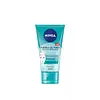What's inside
What's inside
 Key Ingredients
Key Ingredients

 Benefits
Benefits

 Concerns
Concerns

 Ingredients Side-by-side
Ingredients Side-by-side

Water
Skin ConditioningCocamidopropyl Betaine
CleansingSodium Myreth Sulfate
CleansingAcrylates Copolymer
Magnolia Officinalis Bark Extract
AntimicrobialLactic Acid
BufferingGlycerin
HumectantLauryl Glucoside
CleansingSodium Lauryl Sulfate
CleansingPEG-40 Hydrogenated Castor Oil
EmulsifyingPEG-200 Hydrogenated Glyceryl Palmate
CleansingBenzophenone-4
UV AbsorberSodium Chloride
MaskingMicrocrystalline Cellulose
AbsorbentMannitol
HumectantPolyquaternium-10
Sodium Hydroxide
BufferingTrisodium EDTA
Phenoxyethanol
PreservativeMethylparaben
PreservativeEthylparaben
PreservativeCitronellol
PerfumingAlpha-Isomethyl Ionone
PerfumingParfum
MaskingCI 74160
Cosmetic ColorantCI 42090
Cosmetic ColorantWater, Cocamidopropyl Betaine, Sodium Myreth Sulfate, Acrylates Copolymer, Magnolia Officinalis Bark Extract, Lactic Acid, Glycerin, Lauryl Glucoside, Sodium Lauryl Sulfate, PEG-40 Hydrogenated Castor Oil, PEG-200 Hydrogenated Glyceryl Palmate, Benzophenone-4, Sodium Chloride, Microcrystalline Cellulose, Mannitol, Polyquaternium-10, Sodium Hydroxide, Trisodium EDTA, Phenoxyethanol, Methylparaben, Ethylparaben, Citronellol, Alpha-Isomethyl Ionone, Parfum, CI 74160, CI 42090
 Reviews
Reviews

Ingredients Explained
These ingredients are found in both products.
Ingredients higher up in an ingredient list are typically present in a larger amount.
Phenoxyethanol is a preservative that has germicide, antimicrobial, and aromatic properties. Studies show that phenoxyethanol can prevent microbial growth. By itself, it has a scent that is similar to that of a rose.
It's often used in formulations along with Caprylyl Glycol to preserve the shelf life of products.